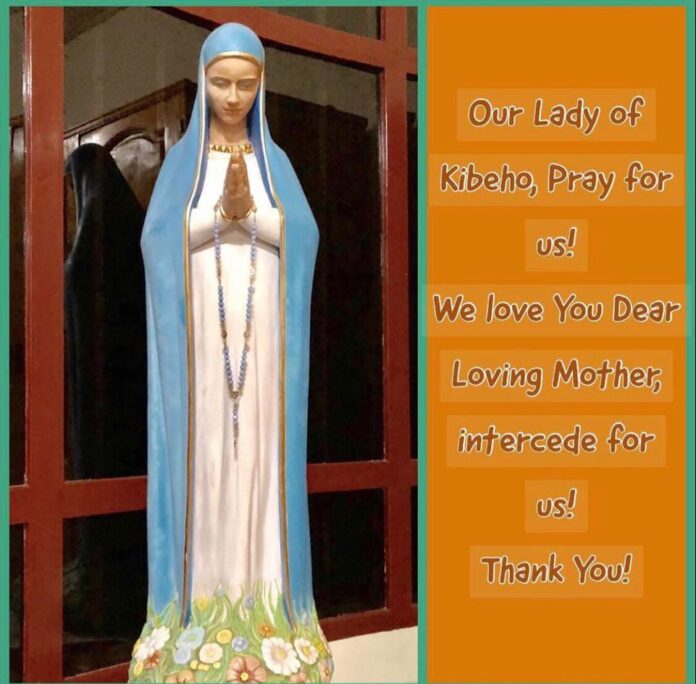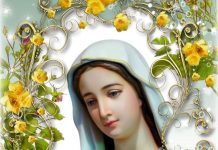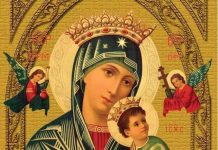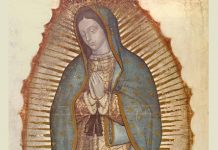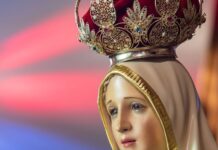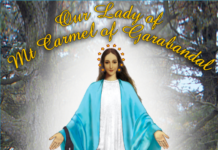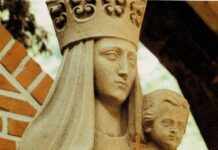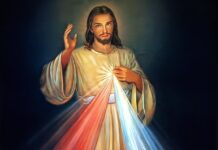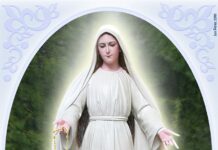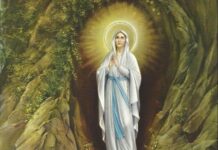Do repent! Do repent! Do repent! One knows that the present situation in schools worldwide is awful, because God has been chased out, because His law is no longer taught. It is even forbidden to pray to Him in schools!
Apparitions of Our Lady in Kibeho 1981 Rwanda
Kibeho: Rwanda in 1980
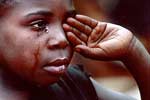
Vandalism was rampant all over the country from 1980 to 1981. Almost all of the statues of the Virgin Mary that were at the entrance of villages were mutilated, destroyed, or stolen. This was a sad time when Mary was almost forgotten, and barely prayed to. Even several priests did not pray the Rosary any more, influenced by the propaganda of false theologians who would like to make us believe that this devotion is out of date. Catholics are humiliated; the clergy begins to give up.
It is in this time of discouragement that Mary chose to visit Rwanda. From 1981 to 1989, this country heard of the Virgin Mary as never before. Kibeho is located in the south of the country, the poorest area of Rwanda. The presence, in this place, of two dynamic priests made the population fervent.
Kibeho: The school of the Apparitions
At the start of the new school year in 1981, there were 120 students, divided into three classes. Three nuns are directing the school. The other teachers – one woman and five men – are lay people. They are all Rwandans. Two are Protestant, the others are Catholic. The majority of the students are Catholic, but there are also 17 Protestant and 2 Moslem students. Morals are far from being exemplary.
Kibeho: The first Apparition

Alphonsine Mumreke, the first seer of Kibeho, is 17 years old, and is in her first year at the secondary school of Kibeho. She is very pious, and has always shown a great love for the Blessed Virgin. She also likes to attend Holy Mass. Here is how she relates the first Apparition: “It took place on Saturday, November 28, 1981, at 12:35 p.m. I was in the dining room of the school, serving my classmates. All of a sudden, I heard a voice calling me.”
Mary: “My daughter.”
Alphonsine: “Here I am.” “I went to the corridor, and saw a very beautiful woman. I knelt down, made the Sign of the Cross, and asked: ‘Who are you?’”
Mary: “Ndi Nyina Wa Jambo (in the local language, ‘I am the Mother of the Word’). In the religion, what do you prefer?”
Alphonsine: “I love God and His Mother, who gave us the Child who redeemed us.”
Mary: “If it is so, I have come to calm you, because I have heard your prayers. I would like your friends to have Faith, because they do not believe strongly enough.”
Alphonsine: “Mother of the Saviour, if it is really You who has come to tell us that here, in this school, we have little Faith, You do love us. I am really filled with joy that You appear to me.”
Alphonsine relates:
“The Virgin was not white as She is usually seen in holy pictures. I could not determine the color of Her skin, but She was of incomparable beauty. She was barefoot and had a seamless white dress, and also a white veil on Her head. Her hands were clasped together on Her breast, and Her fingers pointed to the sky. Later, I was told that I was in the dining room. My classmates told me that I was speaking in several languages: French, English, Kinyarwanda, etc. “When the Blessed Virgin was about to leave, I said three ‘Hail Marys’ and the prayer, ‘Come, Holy Spirit’. When She left, I saw Her rise to Heaven like Jesus.”
At the end of the Apparition, the seer remained motionless for a quarter of an hour, as if she was paralyzed, and all the efforts to get her out of ecstasy were in vain. Neither the teachers nor the nuns gave credence to what Alphonsine said. They rather spoke of illness instead of apparitions.
The phenomenon took place again the next day, on November 29. In December, the Apparitions took place almost every Saturday. Excited by their curiosity, the students and the teachers test the reality of the ecstasies. They burn Alphonsine with a match, or prick her with a pin, but the seer has no reactions.
Alphonsine suffered a lot during this period of subtle persecution. They mocked her: “Here comes the seer!” During the May 8, 1982 Apparition, Alphonsine complained to the Virgin Mary: “People say that we are crazy.” This day, her mother was present for the first time.
Many signs are given by Heaven to bring the students and the teachers to believe in the authenticity of the Apparitions.
The students who had rosaries brought them to have them blessed by the Blessed Virgin. They were all mixed up together, so it was impossible for Alphonsine to know their owners. Alphonsine took the rosaries and offered them to the Blessed Virgin. Some rosaries became too heavy, and the seer could not lift them and ask for the blessing. One then noticed that the heavy Rosary in question belonged to a student who did not believe in the authenticity of the Apparitions, and who criticized them.
There was also, in the dormitory, the Apparition of a star and of sparkling lights that all could see.
If the first Apparition took place in the dining room, during the day, the following Apparitions took place in the evening, in the dormitory, in the room of the seer. The Virgin Mary often told the seer about the date of Her next Apparition.
In Rwanda, news goes fast. People rush up to be present at the time of the Apparitions. Upon the request of the Bishop, the seer spoke about it to the Director of the school. The next meetings will take place outdoors, in the schoolyard. Some Apparitions will continue to take place in the dormitory – private Apparitions that concern only the seer and the students.
Mary will progressively make Herself known to the students, and win them over. She gives advice, encourages, makes remarks to bring them on the right path. She is really the Mother who, in Her motherly love, educates Her children. Our Lady really became the Queen of this school. She should be the Queen of all schools!
One knows that the present situation in schools worldwide is awful, because God has been chased out, because His law is no longer taught. It is even forbidden to pray to Him in schools! Every morning, when we go to Mass, our heart breaks when we see school buses arriving to school, loaded with children. Poor little ones, who are taught that God does not exist! Mary came to Kibeho in a school, to set the example to the whole world, and to show how students can be transformed when God’s law is taught in schools.
Because of the strong opposition that the first Apparitions had caused, some teachers and students had said: “We will believe in the coming in our school of Mary, the Mother of God, only if She appears to others besides Alphonsine.” The seer replied to them: “Pray yourselves to obtain this favor.”
Two other seers
On January 12, 1982, Our Lady grants the prayers of the students, and also appears to a young girl, Anathalie Mukamazimpaka, and will appear to her until December 3, 1983.
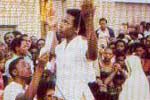

And on March 2, 1982, to the surprise of all, Our Lady appears to Marie Claire Mukangango. It is like a bomb in the school, for Marie Claire was one of those who had showed her unbelief the most. Her Christian life was nothing special, and was even far from being exemplary! She called Alphonsine “a fool”. And now, it is her turn to be seized by a mysterious power. The Virgin Mary chose her to spread Her message, and from now on, Marie Claire keeps saying:
“One must meditate on the Passion of Jesus, and on the deep sorrows of His Mother. One must recite the Rosary every day, and also the Rosary of the Seven Sorrows of Mary, to obtain the favour of repentance.”
Marie Claire will have Apparitions until September 15, 1982.
The blessing of water
In January and February, 1982, diabolical phenomena take place in the dormitory. To cast away these unknown forces, the nuns use Lourdes’ water, which has a soothing effect, but soon there is no more water left. So Anathalie is asked to have some water blessed by the Virgin Mary during the Apparitions. This was on March 2, 1982. Thus started, at Kibeho, the habit of having water blessed by the Virgin Mary before the Apparition. There are now three seers at Kibeho, all from the college. The three of them are now recognized by the Church: Alphonsine, Anathalie, and Marie Claire.
Other Apparition sites
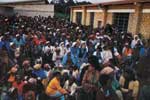
The Apparitions of Mary, that followed the first one to Alphonsine, take place in the dormitory until January 16, 1982, and from that date, either in the schoolyard, for public Apparitions, or in the dormitory of the students, or in a place converted into a chapel. It is there that the students come to pray in the evening, and it will be the moment favored by the Blessed Virgin to visit one of the seers of the school. The students are present during the Apparition, and often the talks with the Virgin are about school life. These Apparitions are considered private, and the public is not allowed.
However, all can attend the Apparitions in the schoolyard. There is a conversation between the seer and the Apparition. All can hear and record the words of the seer, but they obviously cannot hear the words of the Virgin Mary. Very soon, the crowds become larger, especially in May, 1982, the month dedicated to Mary.
A podium and powerful speakers are installed to allow journalists and the members of the medical and theological commission to circulate freely, and above all, to allow the population to hear the dialogue of the seers. On August 15, 1982, there were 20,000 people.
Towards the end of an Apparition, the Blessed Virgin asks the seers to bless the crowd. The seers are in ecstasy; they do not see the crowd, but a garden of flowers, some fresh, and others faded. Our Lady asks the seers to water the flowers, and explains that the fresh flowers represent people whose hearts are turned to God, whereas the faded flowers represent those whose hearts are turned to earthly things, especially to money.
Mystical journeys
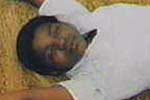
There are also the mystical journeys. Alphonsine experienced this phenomenon on March 20 and 21, 1982. She informs the Sister directress and her classmates in advance: “I will look dead, but don’t be afraid; don’t bury me!” The journey lasts eighteen hours. Priests, nurses, religious, the medical assistant of the Red Cross, all can see Alphonsine plunged into a deep sleep, her body straight and very heavy. They cannot lift her nor separate her hands that are joined. During this journey, the Blessed Virgin shows her Heaven, Purgatory, and Hell.
Another impressive phenomenon that took place in Kibeho was the fasts and the silences requested by Jesus or Mary. This was also checked by the commission of inquiry. These fasts could last up to fourteen days, without harming the health of the seers.
She prays and sings
During one Apparition, Alphonsine is cured of a severe quinsy and of a loss of voice, and also of an eye disease. During the Apparition on October 2, she fell seven times, but even when she lays on the ground, she continues to pray and to sing. She asks for the grace to detest sin, the strength not to be carried away by the desires of the flesh. She sings: “Queen of Heaven and earth.” Then, as an invocation, she repeats: “Let us help Him to save the world…” In her prayers, Alphonsine often asks for vocations to the priesthood and the religious life. She does not forget the youth. She prays for peace because, she says, “there are dissensions, troubles, hatred all over the world.” Finally, she prays for Bishops of Rwanda, the heads of States, and for the whole world.
Two sanctuaries
On August 5, 1982, the Virgin Mary said to Anathalie:
“I speak to you, but you do not hear Me. I want to lift you, but you remain down. I call you, but you turn a deaf ear. When will you do what I ask of you? You remain indifferent to all My appeals. When will you understand? When will you take interest in what I want to say to you? I give you signs, but you remain incredulous. How long will you turn a dead ear to My appeals?”
This long complaint of the Blessed Virgin follows Her request to build two sanctuaries on the place of the Apparitions. Anathalie had told the authorities, but nothing had been done yet. However, the local Bishop and the parish priest were already convinced about the reality of the Apparitions, but they had to go through the usual inquiries.
Repentance
Here is the dialogue that took place between Marie Claire and Mary on April 2, 1982:
Mary: “Do repent! Do repent! Do repent!”
Marie Claire: “But I do!”
Mary: “When I tell you this, I do not speak to you alone, but I speak also to all the others. Men of our times have emptied each thing of its true meaning: he who commits a fault does not recognize that he did wrong.”
Marie Claire: “We are weak, without strength. Give us the strength to recognize our faults and to ask forgiveness for them.” Our Lady recommends to us to say the Rosary of the Seven Sorrows, to obtain the contrition of our sins.
On May 31, 1982, Our Lady said to Marie Claire:
“What I ask of you is repentance. If you recite this chaplet, while meditating on it, you will then have the strength to repent. Today, many people do not know any more how to ask forgiveness. They nail again the Son of God on the Cross. So I wanted to come and recall it to you, especially here in Rwanda, for here I have still found humble people, who are not attached to wealth nor money”.
Our Lady asked us to recite this chaplet every day if we can, but especially on the following days: Friday, the day that recalls the crucifixion of Jesus; Tuesday, in memory of the first Apparition to Marie Claire on Tuesday, March 2, 1982; on September 14, the feast of the Holy Cross; and on September 15, the feast of Our Lady of Seven Sorrows.
A Message for statesmen
Here are excerpts from a Message of our Heavenly Mother to the seer Alphonsine during Her last Apparition on November 28, 1989. It was published in the May-June, 1990 issue of “Michael”:
“I speak to you who hold power, and who represent the nation: save the people, instead of being their torturers. Don’t rob the people; share with others. Be careful not to persecute, to muzzle those who want to denounce your errors. I say it to you, I repeat it, whatever you do, even though you try everything to harm somebody because he loves his fellow men, defends human rights, fights for the respect of the life of others, and for the truth and all that is good, and even because he fights so that God may be loved and respected, whatever you do, you can do nothing against him.”
The Virgin also said to Alphonsine:
“I love you very much. If I came, it is because you needed it.”
Extraordinary phenomena
The pilgrims in Kibeho witnessed several extraordinary phenomena: the dance of the sun from left to right and up and down, for tens of minutes; the disappearance of the sun, replaced by a greenish moon; a dance of the stars; luminous crosses in the sky.
But the greatest miracle in Kibeho was this wave of conversions and prayers that resulted from the Apparitions. The Virgin Mary especially called Her consecrated ones and the youth, these poor young people of our times who go to schools, that are not only without God, but against God!
Bishop Jean Baptiste Gahamanyi
Bishop Jean Baptiste Gahamanyi, who was in charge of the Diocese of Butare at the time of the Apparitions, was interviewed by the French Catholic periodical “Chretiens Magazine” (Jan. 15, 1998 issue). He said:
“At the beginning of January, 1982, I invited Alphonsine to:
– Ask the Virgin Her name, and for whom Her Message was intended – for Kibeho, for Rwanda, for Africa, for the whole world;
– Express clearly Her Message;
– Appear not too late, and in a place large enough to gather many people.
“For the next Apparition, Our Lady appeared in the schoolyard, but not far from the original place of the Apparitions, and this Apparition took place at 3 p.m.
“The Virgin Mary said that the purpose of Her coming was to communicate a message of conversion (through a life of prayer and confession, a life renewed by the Word of God, and by works of charity and justice).
“She had also stated Her name, `the Mother of the Word’, so that one will not mistake Her for another mother: the child to whom She gave birth is God.
“She insisted on the same message of rejection of sin, and recommended the practice of unceasing prayer that keeps us in communion with the Holy Trinity. This is how the devotion to the Seven Sorrows of the Virgin Mary was discovered.
“I have absolutely no doubt that something supernatural took place in Kibeho. The message is true; people must feel concerned.”
A vision of the war later in 1994
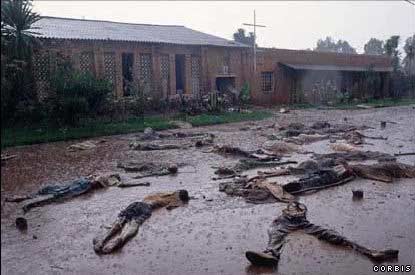
During his 1990 visit to Rwanda, John Paul II exhorted the faithful to turn to the Virgin as a simple and sure guide, and to pray for greater commitment against local divisions, both political and ethnic.
One of the key reasons that brought the competent ecclesiastical authorities to recognize the Apparition of Kibeho as authentic was the anticipated vision of the Rwanda genocide that occurred 12 years later, in 1994. On August 19, 1982, the seers saw “a river of blood, people who were killing each other, abandoned corpses with no one to bury them, a tree all in flames, bodies without their heads.” This prophecy seemed at first incredible, but about a decade later, in the spring of 1994, a horrifying civil war erupted in Rwanda, and, in just three months, an estimated 500,000 to one million were killed, many beheaded by machetes and dumped into the Kagea River (“river of blood”).
The Blessed Virgin had warned us at Kibeho that sexual promiscuity would lead to disaster. That was before the world knew about AIDS, but by 1994, Africa has seventy percent of the world’s AIDS cases – and entire villages were turned into ghost towns! So far, 25 million Africans have contracted AIDS.
But the warnings of the Blessed Virgin Mary were not just for Africa.
“When I tell you this, I am not addressing myself strictly to you, child, but I am making this appeal to the world,” the Virgin told the seer Marie-Clare Mukangango – who was later killed in the war. She said the Virgin described the world as in revolt against God, the world “is on the edge of catastrophe.”
To avoid war and chastisements, the Mother of the Word invited the young seers and the whole world to pray, to fast, and to make penance.
Following the terrible events that took place in the United States, and that are foreshadowing a bloodier and more devastative war, we ask our readers to put into practice the request of Pope John Paul: Pray to avoid war!
And, above all, let us heed the requests of Our Lady: let us convert by going to confession, by confessing our sins with deep sorrow; let us go to Mass every Sunday; let us pray the Rosary by meditating on the mysteries that recall the main events of the life of Our Redeemer, Jesus Christ, related in the Gospel; let us recite the Rosary of the Seven Sorrows that reminds us that Mary took a close part in our Redemption, that She suffered along with Her Son Jesus to save us.
Declaration of the Bishop of Gikongoro (excerpts)
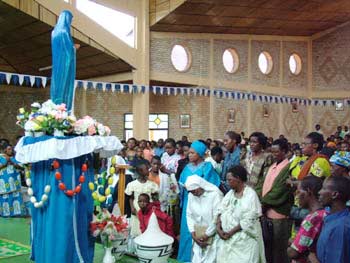
On July 2, 2001, the Holy See released the declaration of Bishop Augustin Misago of Gikongoro, on the Apparitions that took place in 1982-83 in Kibeho. Here are some excerpts:
“Two study commissions, one of doctors and one of theologians, were immediately set up by the local Bishop; they have been at work since April 1982… The advanced state of the study commissions’ work now offers sufficient elements to allow competent ecclesiastical authorities to pronounce definitively on this question.
“As a result, Bishop Augustin Misago of Gikongoro, who represents this authority, has published his declaration concerning the definitive judgement on the Apparitions of Kibeho, Rwanda. This important event in the history of the Diocese of Gikongoro, as in the life of the Church in Rwanda, took place on 29 June 2001, on the solemnity of Sts. Peter and Paul, during a solemn Mass concelebrated in the cathedral of Gikongoro. All the Catholic bishops of Rwanda, with the Apostolic Nuncio of Kigali, were present…
“The Bishop declared: Yes, the Virgin Mary appeared at Kibeho on November 28, 1981, and in the months that followed. There are more reasons to believe in the Apparitions than to deny them… The Apparitions of Kibeho are now officially recognized… The name given to the Marian sanctuary at Kibeho is “Shrine of Our Lady of Sorrows”.
“That Kibeho become a place of pilgrimage and of encounter for all who seek Christ and who come there to pray, a fundamental centre of conversion, of reparation for the sins of the world and of reconciliation, a point of meeting for all who were dispersed, as for those who aspire to the values of compassion and fraternity without borders, a fundamental centre that recalls the Gospel of the Cross.
“This Declaration makes it possible to respond to the expectations of the People of God and to bring new enthusiasm to the public devotion recognized already for 13 years”. (Taken from “L’Osservatore Romano”, weekly edition in English, July 11, 2001, page 8.)
In 1988, without officially approving of the Apparitions, Bishop Jean Baptiste Gahamanyi, of the Diocese of Butare, of which Kibeho was a part at that time, authorized public devotion at the site of the Apparitions. Today, Kinbeho is part of the Diocese of Gikongoro, led by Bishop Augustin Misago.


